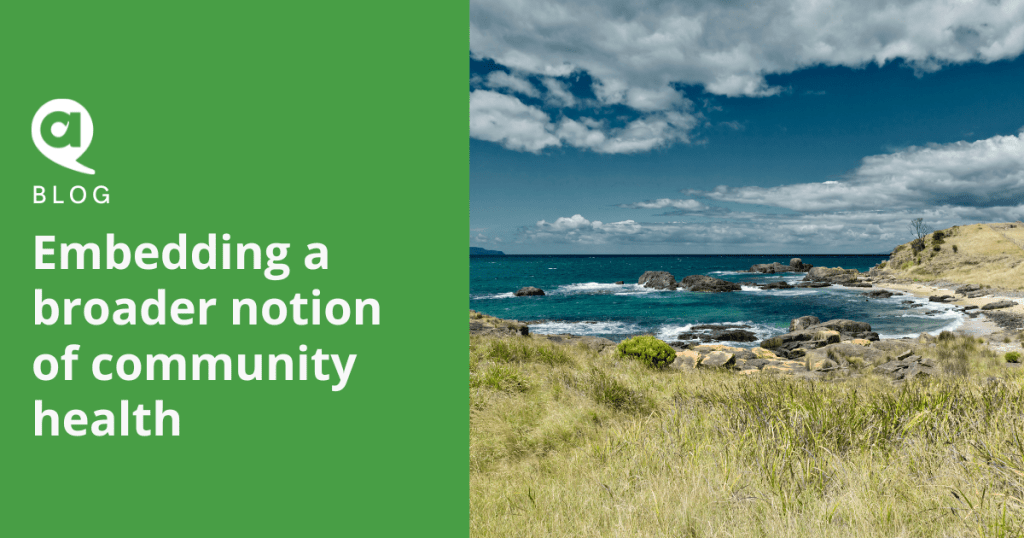
May 2023
By Dr Nicki Taylor UWS & Dr Gabrielle O’Flynn UoW
We acknowledge that Country for Aboriginal peoples is an interconnected set of ancient and sophisticated relationships. We pay our respect and acknowledge the Traditional Custodians of the lands on which learn, work and connect. We recognise the strength, resilience and capacity of the Aboriginal community and pay our respects to the Elders past and present and extend that respect to any Aboriginal and Torres Strait Island people present.
Our focus
Welcome! This blog aims to initiate an examination and questioning of the concept of ‘community health’ in the field of Health and Physical Education (HPE).
While critical health research examines notions of health and well being in general, there is an absence of research that critically analyses meanings of ‘community health’ in HPE. In this blog, we seek to address this absence by exploring which meanings of community health are privileged, which are silenced, and where we can turn to re-imagine a broader and more complex notion of community health.
We invite you to join us in critically examining how community health is defined in HPE and expanding our understanding of community to include the natural world and the environment, thus embracing a more-than-human notion of community. In doing so, we can begin to think more holistically about the way we connect with one another and interact with our community and the natural world.
Community health in HPE
In the Australian schooling subject of Health and Physical Education (HPE), the term ‘community health’ has a substantial presence in curriculum documents. In the current Australian Curriculum: Health and Physical Education (AC:HPE V8.4), the term ‘community health’ is explicitly referred to over 20 times. Across the NSW PDHPE Syllabus (2018), the term ‘community health’ and community feature approximately 10 and 148 times respectively.
The majority of these references direct student learning toward identifying the connections they have to their community, and investigating and using local resources to support their health, wellbeing, safety and opportunity for physical activity. In the AC:HPE V8.4 and NSW PDHPE Syllabus, ‘community health’ and ‘community’ are explicitly defined as:
- Community Health: “Focuses on work within defined communities to maintain and improve the health and wellbeing of all people in that community through collective action” (AC:HPE V8.4).
- Community: “A group of people linked by a common social structure and sense of belonging. This may be based on location, gender, interests, cultural background or political or religious beliefs. It may also refer to a virtual community” (AC:HPE V8.4).
As highlighted in the definitions above, and across HPE curriculum documents, there is a pattern of defining community and community health almost exclusively in the realm of ‘people’.
These definitions of community health are humanistic. Community health is defined in terms of access, action, partnership and behaviour change. These patterns of defining community health stem from a public health origin.
Dominant discourses of community health
The concept of “community health” in HPE has roots in public health movements and health promotion policies.
The World Health Organisation (WHO) has been instrumental in shaping the discourse of community health in education systems. By way of example, the Health Promoting Schools Framework, developed by the WHO, promotes the development of school community partnerships and access to local community services for health promotion. This includes a focus on developing student health literacy, to ensure young people are literate to access, act, engage in partnership, and change their own and others behavior. I
n this way, community health in AC:HPE curriculum is largely framed by a:
- Discourse of access: In particular, this includes a strong focus on developing the ability of young people to access health related ‘information, products, services and environments’ in their communities.
- Discourses of action: An imperative for young people to act, or to take action, that aligns their behaviors with health promotion aims and goals. However, this raises questions of young people’s agency and equal resources to act.
- Discourses of partnership: create partnerships for learning and wellbeing (with parents, community organisations and specialist services).
- Discourse of behaviour change: Ultimately, the above discourses of access, action and partnerships are largely about changing individual health related behaviors, and as a result, the overall community health status for the better – i.e reproducing the goal of public health promotion as defined by the WHO. Health in this sense is understood in terms of maintaining human health, reducing disease and the impact of these on the individual and the burden on the community.
Other ways of thinking about community health in HPE
In contrast to those dominant community health discourses outlined above, ‘community health’ understandings in HPE could be broadened to include meanings that move beyond human centered approaches, to also include the more-than-human.
Such an approach views humans, nature, fauna and flora as part of a wider, collective social-scape that is ‘all connected’.
In this way, when considering matters of community health and well being, the material, biological and more-than-human aspects of the ‘community’ are considered. A focus is placed on adopting a relational perspective of how health and wellbeing of all entities (human and more-than-human) are formed in complex relations to/with each other.
For as long as humans have lived, we have existed in a complex set of biophysical assemblages with the wider ecological community around (and within) us. At the most fundamental level, human beings sit within a web that connects us in complex ways to other living and inanimate entities. At the core of these relationships, are the functions that help to enhance, maintain or degrade the health and functioning of life forms. In other words, human, animal, and environmental health, are deeply interconnected.
In order to better address the interconnectedness of the human and more-than-human world and to help us as HPE educators and researchers re/imagine meanings of ‘community health’ and well being, we turn to the work of Iris Duhn, Donna Haraway and Anthony MacKnight.
Iris Duhn’s work on multi-species communities asks:
- can we learn to make places for living well, and sustainably, together with humans, more-than-humans and vibrant matter of all kinds?
Duhn’s work builds on the idea that we are in a new phase in Earth’s geological history – the Anthropocene – where human kind is now considered the most influential thing on the earths systems. She shares her concern that we are rapidly moving towards a sixth mass extinction of species unless we find better ways of sharing the planet in sustainable ways for all – and connected as they are, human health and wellbeing will not be exempt from the consequences of such events.
Donna Haraway has also called for new ways to consider ‘community’, arguing that a bigger sense of community is needed based on empathy, accountability and recognition – extending to the nonhuman world. These ecological communities – where we are all ‘beings’ in common – means we can’t be exempt from the effects or consequences of being in this common world together.
Anthony McKnight’s work calls for placing Country centre. Anthony adopts a perspective of an Aboriginal ontology, in particular Yuin ontology of oneness which is useful for framing community health through the concept of connecting to and caring for Country.
McKnight, in collaboration with Crystal Arnold and Jennifer Atchison, shares:
“Country is not only a place, area of and, or vegetation, Country is all beings, from a blade of grass, to the wind and the Ancestors. Country is more than these things and more than the sum of these parts. On Country everything is alive; Country is a principle source of knowledge” (Arnold, Atchison, McKnight, 2021, p134).
We all have a responsibility to care for Country (O’Flynn, McKnight, Probst & Stanley, 2022) – to ‘give back’ to Country (Arnold et al, 2021).
PDHPE Masterclass
Join Nicki and Gabrielle to discuss this topic further at their PDHPE Masterclass on 11 May 2023. Learn more
References & further reading
This article was first published here.
Arnold, C.; Atchison, J.; & McKnight, A. (2021). Reciprocal relationships with trees: rekindling Indigenous wellbeing and identity through the Yuin ontology of oneness, Australian Geographer, 52:2, 131-147.
Duhn I, ‘Making ‘place’ for ecological sustainability in early childhood education’, Environmental Education Research, 18, (1) pp. 19-29.
Haraway, D. (2015). Anthropocene-Capitalocene-Plantationocene: Making Kin, Environmental Humanities, 6 (1): 159–165.
Lloyd, K., Wright, S., Suchet-Pearson, S., Laklak Burarrwanga & Bawaka Country (2012) Reframing Development through Collaboration: towards a relational ontology of connection in Bawaka, North East Arnhem Land, Third World Quarterly, 33:6, 1075-1094.
McKnight, A. (2015) Mingadhuga Mingayung: Respecting Country through Mother Mountain’s stories to share her cultural voice in Western academic structures. Educational Philosophy and Theory, 2015, 47, (3), 276-29 .
McKnight, A. (2016) Preservice teachers’ learning with Yuin Country: becoming respectful teachers in Aboriginal education, Asia-Pacific Journal of Teacher Education, 44:2, 110-124.
McKnight, A (2017) Singing Up Country in Academia: Teacher education academics and preservice teachers’ experience with Yuin Country. PhD Thesis, University of Wollongong.
O’Flynn,G.; McKnight,A.;Probst,Y.; Tillott. S. & Stanley, R.M. (2022): Australian Aboriginal children talking culture: what does ‘seeing’ Country and the ‘child spirit’ mean for health educators?, Sport, Education and Society, DOI: 10.1080/13573322.2022.2140404
Taylor N, Wright, J.; & O’Flynn G.(2019) Embodied encounters with more-than-human nature in health and physical education,Sport, Education and Society, 24(9):914-924


